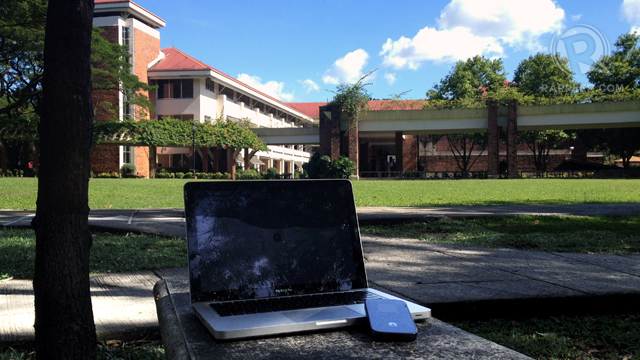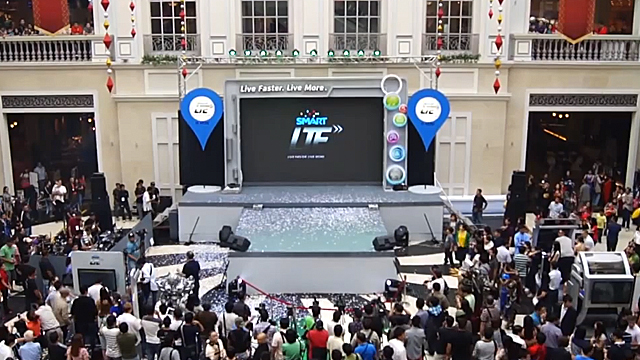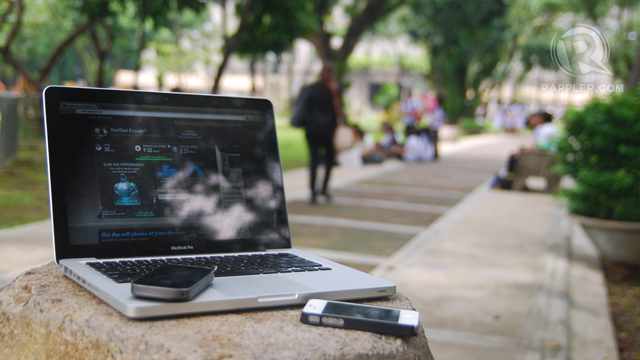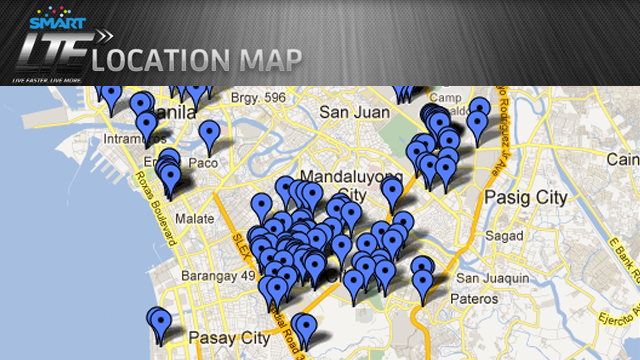SUMMARY
This is AI generated summarization, which may have errors. For context, always refer to the full article.

MANILA, Philippines – “8 days without Internet? That’s a crime!”
I explained to my colleague Carlos Santamaria as we discussed vacation options the other day. Carlos was suggesting I go on a dive trip to Tubbataha, but the idea of being off the grid for over a week scared me.
Because of my digital lifestyle, uninterrupted Internet connectivity is both a necessity and a security blanket of sorts. I get panic attacks when I am unable to connect to the Internet for an extended period of time. The same insecure feeling I get when I’m out and about without a wallet.
Mobile Internet in particular has become and integral part of my life and it transcends both work and play. I need connectivity to access the documents I store on the cloud, to stream my podcasts, to get my news, to download new books, and to stay connected with the ever growing social media community. And I need fast, reliable Internet whether I’m at a university speaking at an event, at the mall eating out with friends, out clubbing on a Saturday night, or traversing EDSA to and from work.
It’s no longer a want, it’s a need, and I demand it from my telco. But I’m not alone. These days users are quick to rant on social media when they have connectivity issues, coverage and speed being the most critical of concerns.
HISTORY OF MOBILE INTERNET
We’re spoiled by technology. Just a decade ago mobile Internet was unheard of.
The first generation mobile phones were analogue 1G networks.
If you’re not old enough, these were brick-sized phones that had antennas you’d have to pull out for better coverage. They got smaller towards the end of product cycle, but they could only do one thing, make phone calls. Shocker I know, but true.
In the Philippines, the late 90s ushered in digital 2G networks that aside from voice allowed users to send text messages via the Short Messaging Service (SMS).
It wasn’t until 2.5G came around when digital networks got the ability to send and receive packet data that users got some form of Internet on their phones. Barebones sites available during this time were called WAP sites – but the infrastructure wasn’t robust and connectivity was restricted to a measly 20-40kbps. In people speak, these sites were barely usable.
Luckily enough with each passing G (generation) the technology got better, more capable and as a result much faster. When 3G came around in the early 2000s I got myself a Nokia 3650, one of the first phones that allowed users to make video calls. 3G networks ran off a technology called EDGE which finally provided decent mobile Internet, but it wasn’t till 3.5G that we could get Internet speeds that mirrored the experience we could get at home.
3.5G HSDPA networks allow real world speeds of a very comfortable 1 to 3Mbps.
Sometimes I marvel at the ability to download a 7MB mp3 in a just over a minute whereas a decade ago, at an Internet shop near school, it would take forever to download a 1MB file. Much has changed since, and for the better.
4G IS THE FUTURE
But we’re only getting started. These days the new buzz word in the telecommunications space is 4G. Unlike 3G however there isn’t a standard yet – and two technologies, WiMax and LTE are fighting over who gets bragging rights to be called true 4G.
WiMax is a standard developed in South Korea back in 2006. Think of it as you would WiFi but at a much larger scale – instead of a house, think citywide coverage. That’s no exaggeration, in fact some cities like Atlanta, Georgia are covered by one big WiMax hotspot.
Then you have Long Term Evolution or LTE. Proposed back in 2004, LTE was formed out of a desire to take 3G into the future. And what a great future it could be with theoretical speeds of up to 100Mbps possible.
LTE LAUNCHED
As early as April 2011 Smart began testing LTE in Boracay but it wasn’t until August of 2012 that both Smart and Globe announced the arrival of 4G LTE services. A closer look at the fine print however revealed that not all local LTE networks were ready for the big time.
Truth be told, while demo tests during the event showed off speeds nearing 50Mbps, Globe’s LTE services were not commercially available to subscribers then. Instead they unveiled plans and raffled out trips to Singapore to those who signed-up in advance for the service. The service finally rolled out to users on October 28 with 45 sites in the Makati area.

Smart’s services were available on launch day with about 50 sites across 5 cities of Metro Manila. 3 months later, they have expanded to 200 sites across the metropolis, with new sites being put up in Cebu also.
Both telcos offer two data plans (detailed in the chart below) with corresponding data caps – meaning starting February 2013, when unlimited promos expire, you can surf only until you hit your data cap, after which you’ll have to pay more.
| Plan | Data Cap** | Promised Speeds | Free Device | |
| GLOBE | P 1,799 | 12 GB | Up to 20Mbps | USB Stick |
| P 2,499 | 15 GB | Up to 42Mbps | MiFi | |
| SMART | P 1,749 | 10 GB | Up to 42Mbps | USB Stick |
| P 3,500 | 21 GB | Up to 42Mbps | MiFi |
**Both Smart and Globe are offering unlimited data plans until January 31, 2013
***Users on Smart’s 1749 plan can upgrade to a MiFi device for a fee.
THE STATE OF LTE
Strip away the marketing speak however and you’re left with questions about what’s important to us users – breadth of coverage and real world speeds.

That’s why in early October I set off on a #GoodLTEhuting trip around Metro Manila (documented on Twitter) to see for myself the true state of LTE in the Philippines. Smart lent me one of the LTE Pocket WiFi devices they launched that week. I reached out to Globe the same day but they told me they could only loan me a device when their LTE network rolled out to consumers on October 28. Fast forward to a month later and I’m still waiting for that test unit. More on that in a bit.
Since the goal was to verify telco claims against real world performance I identified several Smart LTE hotspots in several cities across Metro Manila and ran a series of tests at each spot: bandwidth test (via speedtest.net), downloading a 7.5MB song from the iTunes music store, and loading a video on YouTube (in both 720p and 360p). Here are the results.
| SmartLTE Location |
Speed Test | 7.5MB song from iTunes Store | #AskMargie (TRT 8:04) http://youtu.be/ig-4H3o5DfI |
||
| Down | Up | YouTube 720p |
YouTube 360p |
||
| MANILA | |||||
| University of Santo Tomas | 10.64 Mbps | 1.87 Mbps | 0:13 | 2:25 | 0:45 |
| Mall of Asia | 21.61 Mbps | 3.73 Mbps | 0:08 | 4:38 | 0:54 |
| TAGUIG | |||||
| Bonifacio High Street | 6.40 Mbps | 3.43 Mbps | 0:14 | 1:42 | 1:41 |
| Serendra | 9.34 Mbps | 5.33 Mbps | 0:11 | 2:30 | 0:48 |
| Burgos Circle | 5.49 Mbps | 1.21 Mbps | 0:12 | 1:53 | 1:39 |
| MAKATI | |||||
| Greenbelt 3 | 4.67 Mbps | 1.41 Mbps | 0:27 | 4:38 | 1:38 |
| QUEZON CITY | |||||
| Maginhawa St, Teacher’s Village | 11.86 Mbps | 4.52 Mbps | 0:06 | 4:46 | 5:58 |
| University of the Philippines | 6.28 Mbps | 2.00 Mbps | 0:20 | 3:22 | 1:41 |
| Ateneo De Manila University | 7.68 Mbps | 2.77 Mbps | 0:09 | 1:50 | 0:36 |
FINDINGS
If you’ll notice the results were quite varied. Smart LTE speeds in the Manila area were fastest. I also recorded speeds of between 19-21Mbps while in a moving vehicle traversing A.H. Lacson.
Regardless of the Speedtest scores however, I got really good download speeds throughout. It just gets tougher when trying to download/stream larger files.

Makati was a bit of a disappointment, I had hoped to get faster speeds in the Greenbelt area as that’s where people flock to on weekends.
Bonifacio High Street and Serendra speeds were great, considering the Smart LTE hotspot was all the way at Market Market. Again because there is so much activity in these two areas Smart should be setting up more towers to cover Serendra all the way to the Bonifacio High Street Extension, as well as the Fort Strip.
The Smart LTE coverage inside my almae matres UP Diliman and ADMU was great at key locations. Wishing LTE was around when I was a student. Signal was also great along Maginhawa St. in Teachers Village where there is a strip of restaurants. There was a faint 4G signal at home but not enough to really be an alternative – which was disappointing, as coverage at home would have been the overriding reason to get me to subscribe.
Overall Smart LTE speeds were great where it was promised. Coverage for now is not as thick as 3G or HSDPA is – so if its LTE speeds you’re after then make sure you work and play around these areas. If not and you still want to bite the bullet – be prepared to live through the pains of being an early adapter.
But it’s not so bad really. One day I left my Smart LTE portable WiFi device on while driving home from Makati to Quezon City and I was able to tune in to a live stream of an event without interruptions. Connectivity in EDSA is always a pet peeve – and to get a consistent reliable connection on EDSA from Makati to QC was a gift. Everyday without fail, on my iPhone, (won’t mention my provider) my connection drops from 3G to EDGE when I reach Cubao and then again during the stretch from Santolan to Ortigas flyover.
MOVING FORWARD

While I know they’ve activated more sites in the 3 months since they launched, I can’t stress enough to Smart the need to roll out more sites. I would hate to see it be a waiting game – where Smart is waiting for user demand, while users are waiting for greater coverage. Of course that’s easier said than done as there are cost implications to roll out a new site, but the good news is, at least where Smart is concerned its just a matter of turning switches on. If you don’t have coverage in your area, I’d let them know – perhaps with enough people asking for it – they’d get a better picture of which areas to roll out too.
Globe on the other hand is still in the process of implementing its network transformation program, a massive US$700-M project that should solve some of the problems existing subscribers are experiencing. It argues that instead of setting up “pocket activations” across Metro Manila (like what Smart is doing), it is focusing on “large contiguous areas”. Its first site is the Central Business District of Makati. In theory the idea makes sense, during my tests I had Smart LTE connectivity at each pre-determined spot on my list – but not during the commute from point to point – which is what, in the real world, users need.
There’s no way to test Globe’s theory however as devices are scarce and they are unable to loan test devices. Over the course of my tests with Smart LTE I reached out to Globe reps to follow up my request. I was always told they’d follow up. Three days before this article was due, and urgent for some Globe LTE test results, I sent out a tweet inquiring if any of my followers were on Globe LTE. The responses were sarcastic, one user responded, “Globe has LTE?” Another user responded, “same question”, third chimed in, “in the form of a press release.” The day after this Twitter conversation took place a representative from Globe’s social media team texted me saying they would send a test unit over, but that device has yet to arrive.
Reps from Globe also tell me, that since October 28 you can walk into their Greenbelt 4 store and with the submission of necessary requirements walk out with a Globe LTE device and plan. Last November 29 I visited the GB4 Globe store to verify this claim, but when I inquired, I was told that units were not available. The LTE smartphones they announced last October 3 were also not available. Because it’s limited to Makati City only, for now I’d recommend their service only to users who spend more of their time in the Makati area.
All that said we’re only at the early stages of LTE rollout. As planned LTE looks to be a huge step forward in terms of mobile internet connectivity. In time, as it rolls out to more of the country and as more Filipinos go online, it will play a big part in what and how we do things online.
I’ve seen the future and it looks good, if you can afford it and you live within the radius of LTE hotspots then go for it. But for the rest of us, as LTE plans come at a premium, I’d say it would be prudent to wait it out a few months. Wait till prices go down and coverage improves. – Rappler.com
Add a comment
How does this make you feel?
There are no comments yet. Add your comment to start the conversation.